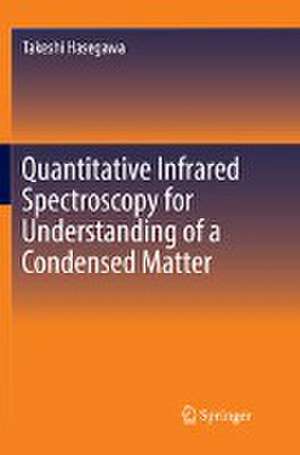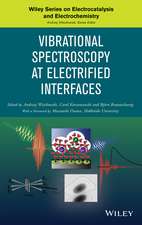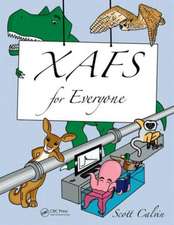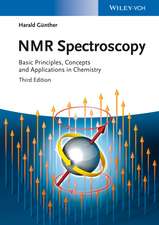Quantitative Infrared Spectroscopy for Understanding of a Condensed Matter
Autor Takeshi Hasegawaen Limba Engleză Paperback – 25 iul 2018
| Toate formatele și edițiile | Preț | Express |
|---|---|---|
| Paperback (1) | 871.16 lei 6-8 săpt. | |
| Springer – 25 iul 2018 | 871.16 lei 6-8 săpt. | |
| Hardback (1) | 877.05 lei 6-8 săpt. | |
| Springer – 3 mai 2017 | 877.05 lei 6-8 săpt. |
Preț: 871.16 lei
Preț vechi: 1062.40 lei
-18% Nou
Puncte Express: 1307
Preț estimativ în valută:
166.77€ • 171.52$ • 138.36£
166.77€ • 171.52$ • 138.36£
Carte tipărită la comandă
Livrare economică 17 februarie-03 martie
Preluare comenzi: 021 569.72.76
Specificații
ISBN-13: 9784431568025
ISBN-10: 4431568026
Ilustrații: XI, 200 p. 115 illus., 55 illus. in color.
Dimensiuni: 155 x 235 mm
Greutate: 0.3 kg
Ediția:Softcover reprint of the original 1st ed. 2017
Editura: Springer
Colecția Springer
Locul publicării:Tokyo, Japan
ISBN-10: 4431568026
Ilustrații: XI, 200 p. 115 illus., 55 illus. in color.
Dimensiuni: 155 x 235 mm
Greutate: 0.3 kg
Ediția:Softcover reprint of the original 1st ed. 2017
Editura: Springer
Colecția Springer
Locul publicării:Tokyo, Japan
Cuprins
Infrared spectroscopy as a vibrational spectroscopy.- Normal modes.- Light absorption by a molecule: 1. Understanding by quantum mechanical approach.- Selection rule of IR spectroscopy.- Light absorption by a molecule: 2. Understanding by electrodynamical approach.- Fundamentals of FT-IR.- Two representations of spectra: Time- and frequency-domain representations.- Fourier transform relationship.- Introduction of Michaelson interferometer.- Representative detectors.- Sampling techniques.- Surface analysis using FT-IR.- Boundary conditions in electrodynamics.- Thin-film approximation.- Surface selection rules for surface spectroscopies.- Chemometrics for FT-IR.- Limitation of Beer’s law.- Expansion of Beer’s law: CLS regression.- Inverse Beer’s law: ILS regression.- Mathematical expansion of CLS: PCA.- Merge of ILS and PCA: PCR.- Independent residual terms: PLS.
Notă biografică
Prof. Takeshi Hasegawa (Kyoto University)
2015 Academic Prize, Chemical Society of Japan
2013 JAIMA Award for Development of Analytical Instrument
2009 The Clara Craver Award, Coblentz Society
2007 Yamazaki-Teiichi Prize
2005 Masao Horiba Awards
2001 Young Scientist Award, Japanese Society for Analytical Chemistry
2001 Young Investigator Award, Spectroscopical Society of Japan
2015 Academic Prize, Chemical Society of Japan
2013 JAIMA Award for Development of Analytical Instrument
2009 The Clara Craver Award, Coblentz Society
2007 Yamazaki-Teiichi Prize
2005 Masao Horiba Awards
2001 Young Scientist Award, Japanese Society for Analytical Chemistry
2001 Young Investigator Award, Spectroscopical Society of Japan
Textul de pe ultima copertă
This book is intended to provide a course of infrared spectroscopy for quantitative analysis, covering both bulk matter and surface/interface analyses. Although the technology of Fourier transform infrared (FT-IR) spectroscopy was established many years ago, the full potential of infrared spectroscopy has not been properly recognized, and its intrinsic potential is still put aside. FT-IR has outstandingly useful characteristics, however, represented by the high sensitivity for monolayer analysis, highly reliable quantitativity, and reproducibility, which are quite suitable for surface and interface analysis. Because infrared spectroscopy provides rich chemical information—for example, hydrogen bonding, molecular conformation, orientation, aggregation, and crystallinity—FT-IR should be the first choice of chemical analysis in a laboratory. In this book, various analytical techniques and basic knowledge of infrared spectroscopy are described in a uniform manner. In particular, techniquesfor quantitative understanding are particularly focused for the reader’s convenience.
Caracteristici
Broadens overall understanding of infrared spectroscopy for material characterization Provides a uniform course of quantitative analysis of infrared spectra Covers both electrodynamic and chemometric approaches Includes supplementary material: sn.pub/extras








